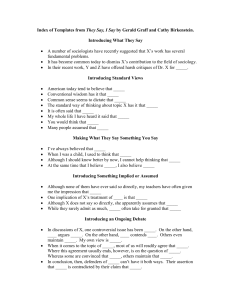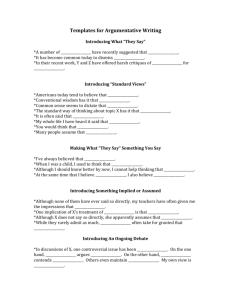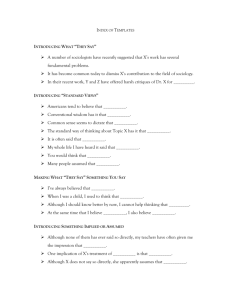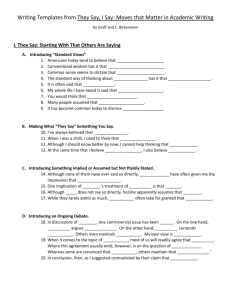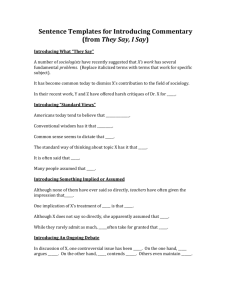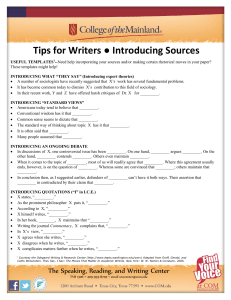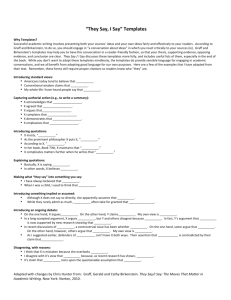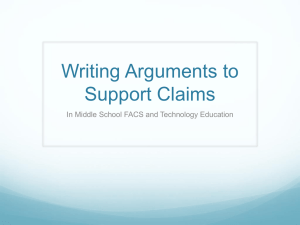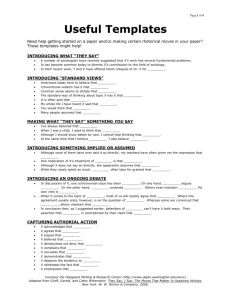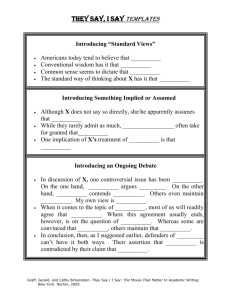Transitions
advertisement
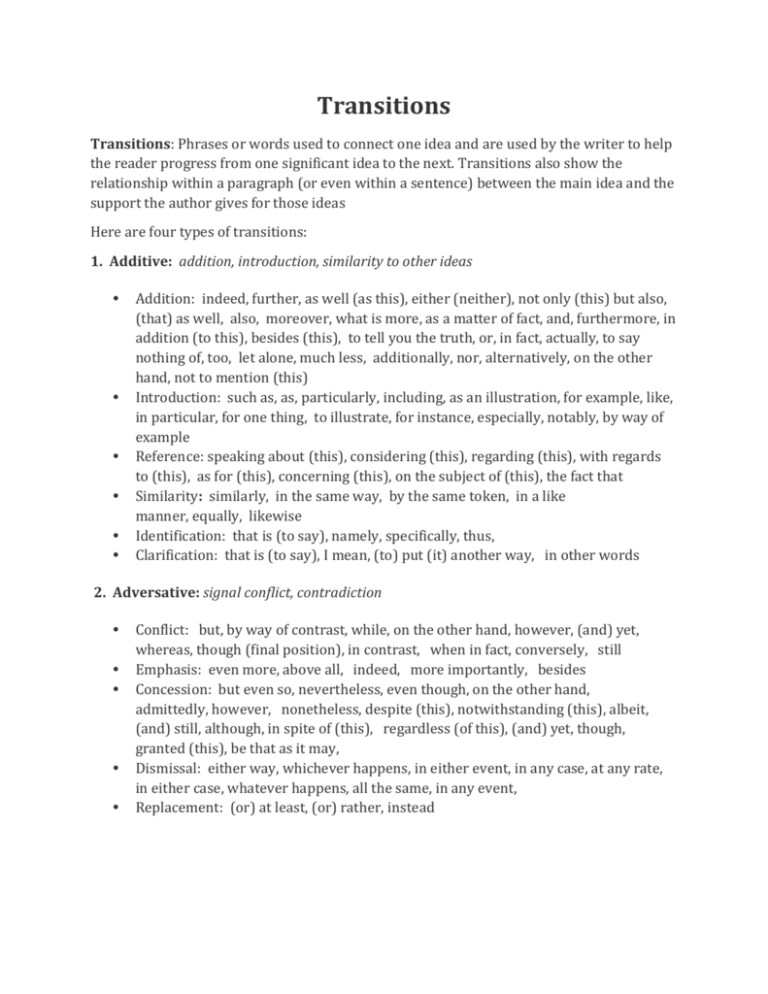
Transitions Transitions: Phrases or words used to connect one idea and are used by the writer to help the reader progress from one significant idea to the next. Transitions also show the relationship within a paragraph (or even within a sentence) between the main idea and the support the author gives for those ideas Here are four types of transitions: 1. Additive: addition, introduction, similarity to other ideas Addition: indeed, further, as well (as this), either (neither), not only (this) but also, (that) as well, also, moreover, what is more, as a matter of fact, and, furthermore, in addition (to this), besides (this), to tell you the truth, or, in fact, actually, to say nothing of, too, let alone, much less, additionally, nor, alternatively, on the other hand, not to mention (this) Introduction: such as, as, particularly, including, as an illustration, for example, like, in particular, for one thing, to illustrate, for instance, especially, notably, by way of example Reference: speaking about (this), considering (this), regarding (this), with regards to (this), as for (this), concerning (this), on the subject of (this), the fact that Similarity: similarly, in the same way, by the same token, in a like manner, equally, likewise Identification: that is (to say), namely, specifically, thus, Clarification: that is (to say), I mean, (to) put (it) another way, in other words 2. Adversative: signal conflict, contradiction Conflict: but, by way of contrast, while, on the other hand, however, (and) yet, whereas, though (final position), in contrast, when in fact, conversely, still Emphasis: even more, above all, indeed, more importantly, besides Concession: but even so, nevertheless, even though, on the other hand, admittedly, however, nonetheless, despite (this), notwithstanding (this), albeit, (and) still, although, in spite of (this), regardless (of this), (and) yet, though, granted (this), be that as it may, Dismissal: either way, whichever happens, in either event, in any case, at any rate, in either case, whatever happens, all the same, in any event, Replacement: (or) at least, (or) rather, instead 3. Causal: signal cause/effect and reason/result Cause/Reason: for the (simple) reason that, being that, for, in view of (the fact), inasmuch as, because (of the fact), seeing that, as, owing to (the fact), due to (the fact that), in that since, forasmuch as Condition: on (the) condition (that), granted (that), if, provided that, in case, in the event that, as/so long as, unless, given that, granting (that), providing that, even if, only if Effect/Result: as a result (of this), consequently, hence, for this reason, thus, because (of this), in consequence, so that, accordingly, as a consequence, so much (so) that, so, therefore, Purpose: for the purpose of, in the hope that, for fear that, so that, with this intention, to the end that, in order to, lest, with this in mind, in order that, so as to, so Consequence: under those circumstances, then, in that case, if not, that being the case, if so, otherwise 4. Sequential: chronological or logical sequence Numerical: in the (first, second, etc.) place, initially, to start with, first of all thirdly, (&c.) to begin with, at first, for a start, secondly, Continuation: subsequently, previously, eventually, next, before (this), afterwards, after (this), then Conclusion: to conclude (with), as a final point, eventually, at last, last but not least, in the end, finally, lastly, Digression: to change the topic, incidentally, by the way, Resumption: to get back to the point, to resume, anyhow, anyway, at any rate, to return to the subject Summation: as was previously stated, so, consequently, in summary, all in all, to make a long story short, thus, as I have said, to sum up, overall, as has been mentioned, then, to summarize, to be brief, briefly, given these points, in all, on the whole, therefore, as has been noted, hence, in conclusion, in a word, to put it briefly, in sum, altogether, in short, Templates Useful Templates INTRODUCING WHAT “THEY SAY” A number of sociologists have recently suggested that X’s work has several fundamental problems. Is has become common today to dismiss X’s contribution to this field of sociology. In their recent work, Y and Z have offered harsh critiques of Dr. X for _________. INTRODUCING “STANDARD VIEWS” Americans today tend to believe that _________. Conventional wisdom has it that _________. Common sense seems to dictate that _________. The standard way of thinking about topic X has it that _________. It is often said that _________. My whole life I have heard it said that _________. You would think that _________. Many people assumed that _________. MAKING WHAT “THEY SAY” SOMETHING YOU SAY I’ve always believed that _________. When I was a child, I used to think that _________. Although I should know better by now, I cannot help thinking that _________. At the same time that I believe _________. I also believe _________. INTRODUCING SOMETHING IMPLIED OR ASSUMED Although none of them have ever said it so directly, my teachers have often given me the impression that _________. One implication of X’s treatment of _________ is that _________. Although X does not say so directly, she apparently assumes that _________. While they rarely admit as much, _________ often take for granted that _________. INTRODUCING AN ONGOING DEBATE In discussions of X, one controversial issue has been _________. On one hand, _________ argues _________. On the other hand, _________ contends _________. Others even maintain _________. My own view is _________. When it comes to the topic of _________, most of us will readily agree that _________. Where this agreement usually ends, however, is on the question of _________. Whereas some are convinced that _________, others maintain that _________. In conclusion then, as I suggested earlier, defenders of _________ can’t have it both ways. Their assertion that _________ in contradicted by their claim that _________. CAPTURING AUTHORIAL ACTION X acknowledges that _________. X agrees that _________. X argues that _________. X believes that _________. X denies/does not deny that _________. X complains that _________. X concedes that _________. X demonstrates that _________. X deplores the tendency to _________. X celebrates the fact that _________. X emphasizes that _________. X insists that _________. X observes that _________. X questions whether _________. X refutes the claim that _________. X reminds us that _________. X reports that _________. X suggests that _________. X urges us to _________. INTRODUCING QUOTATIONS X states, “_________.” As the prominent philosopher X puts it, “_________.” According to X, “_________.” X himself writes, “_________.” In her book, ________, X maintains that “_________.” Writing the journal Commentary, X complains that, “_________.” In X’s view, “_________.” X agrees when she writes, “_________.” X disagrees when he writes, “_________.” X complicates matters further when he writes, “_________.” EXPLAINING QUOTATIONS Basically, X is saying _________. In other words, X believes _________. In making this comment, X argues that _________. X is insisting that _________. X’s point is that _________. The essence of X’s argument is that _________. DISAGREEING, WITH REASONS I think X is mistaken because she overlooks _________. X’s claim that _________ rests upon the questionable assumption that _________. I disagree with X’s view that _________ because, as recent research has shown, _________. X contradicts herself/can’t have it both ways. On the one hand, she argues _________. But on the other hand, she also says _________. By focusing on _________, X overlooks the deeper problem of _________. X claims _________, but we don’t need him to tell us that. Anyone familiar with _________ has long known that _________. AGREEING—WITH A DIFFERENCE I agree that _________ because my experience _________ confirms it. X is surely right about _________ because, as she may not be aware, recent studies have shown that _________. X’s theory of _________ is extremely useful because it sheds insight on the difficult problem of _________. I agree that _________, a point that needs emphasizing since so many people believe _________. Those unfamiliar with this school of thought may be interested to know that it basically boils down to _________. If group X is right that _________, as I think they are, then we need to reassess the popular assumption that _________. EMBEDDING VOICE MARKERS X overlooks what I consider an important point about _________. My own view is that what X insists is a _________ is in fact a _________. I wholeheartedly endorse what X calls _________. These conclusions, which X discusses in _________, add weight to the argument that _________. AGREEING AND DISAGREEING SIMUTANEOUSLY Although I agree with X up to a point, I cannot accept his overall conclusion that _________. Although I disagree with much that X says, I fully endorse his final conclusion that _________. Though I concede _________, I still insist that _________. Whereas X provides ample evidence that _________, Y and Z’s research on _________ and _________ convinces me that _________ instead. X is right that _________, but she seems on more dubious ground when she claims that _________. While X is probably wrong when she claims that _________, she is right that _________. I’m of two minds about X’s claim that _________. On the one hand, I agree that _________. On the other hand, I’m not sure if _________. My feelings on the issue are mixed. I do support X’s position that _________, but I find Y’s argument about _________ and Z’s research on _________ to be equally persuasive. SIGNAL WHO IS SAYING WHAT X argues _________. According to both X and Y, _________. Politicians _________, X argues, should _________. Most athletes will tell you that _________. My own view, however, is that _________. I agree, as X may not realize, that _________. But _________ are real, and arguably, the most significant factor in _________. But X is wrong that _________. However, it is simply not true that _________. Indeed, it is highly likely that _________. But the view that _________ does not fit all the facts. X is right that _________. X is wrong that _________. X is both right and wrong that _________. Yet a sober analysis of the matter reveals _________. Nevertheless, new research shows _________. Anyone familiar with _________ should see that _________. ENTERTAINING OBJECTIONS At this point I would like to raise some objections that have been inspired by the skeptic in me. She feels that I have been ignoring ________. “_________,” she says to me, “_________. Yet some readers may challenge the view that _________. After all, many believe _________. Indeed, my own argument that _________ seems to ignore _________ and _________. Of course, many will probably disagree with this assertion that _________. NAMING YOUR NAYSAYERS Here many feminists would probably object that _________. But social Darwinists would certainly take issue with the argument that _________. Biologists, of course, may want to dispute my claim that _________. Nevertheless, both followers and critics of Malcolm X will probably argue that _________. Although not all Christians think alike, some of them will probably dispute my claim that _________. Non-native English speakers are so diverse in their views that it’s hard to generalize about them, but some are likely to object on the grounds that _________. INTRODUCING OBJECTIONS INFORMALLY But is my proposal realistic? What are the chances of its actually being adopted? Yet is it always true that _________? Is it always the case, as I have been suggesting, that _________? However, does the evidence I’ve cited prove conclusively that _________? “Impossible,” you say. “Your evidence must be skewed.” MAKING CONCESSIONS WHILE STILL STANDING YOUR GROUND Although I grant that _________, I still maintain that _________. Proponents of X are right to argue that _________. But they exaggerate when they claim that _________. While it is true that _________, it does not necessarily follow that _________. On the one hand, I agree with X that _________. But on the other hand, I still insist that _________. INDICATING WHO CARES _________ used to think _________. But recently [or within the past few decades] _________ suggests that _________. What this new research does, then, is correct the mistaken impression, held by many earlier researchers, that _________. These findings challenge the work of earlier researchers, who tended to assume that _________. Recent studies like these shed new light on _________, which previous studies had not addressed. Researchers have long assumed that _________. For instance, one eminent scholar of cell biology, _________, assumed in _________, her seminal work on cell structures and functions that fat cells _________. As _________ herself put it, “_________” (200). Another leading scientist, _________, argued that fat cells “_________” (200). Ultimately, when it came to the nature of fat, the basic assumption was that _________. If sports enthusiasts stopped to think about it, many of them might simply assume that the most successful athletes _________. However, new research shows _________. These findings challenge dieter’s common assumptions that _________. At first glance, teenagers appear to _________. But on closer inspection _________. ESTABLISHING WHY YOUR CLAIM MATTERS X matters/is important because _________. Although X may seem trivial, it is in fact crucial in terms of today’s concern over _________. Ultimately, what is at stake here is _________. These findings have important consequences for the broader domain of _________. My discussion of X is in fact addressing the larger matter of _________. These conclusions/This discovery will have significant applications in _________ as well as in _________. Although X may seem of concern to only a small group of _________, is should in fact concern anyone who cares about _________. ADDING METACOMMENTARY In other words, What _________ really means by this is Essentially, I am arguing that My point is not that we should _________, but that we should _________. What _________ really means is _________. In other words, _________. To put it another way, _________. In sum, then, _________. My conclusion, then, is that, _________. In short, _________. What is more important, _________. Incidentally, _________. By the way, _________. Chapter 2 explores, _________, while Chapter 3 examines _________. Having just argued that _________, let us now turn our attention to _________. Although some readers may object that _________, I would answer that _________.
